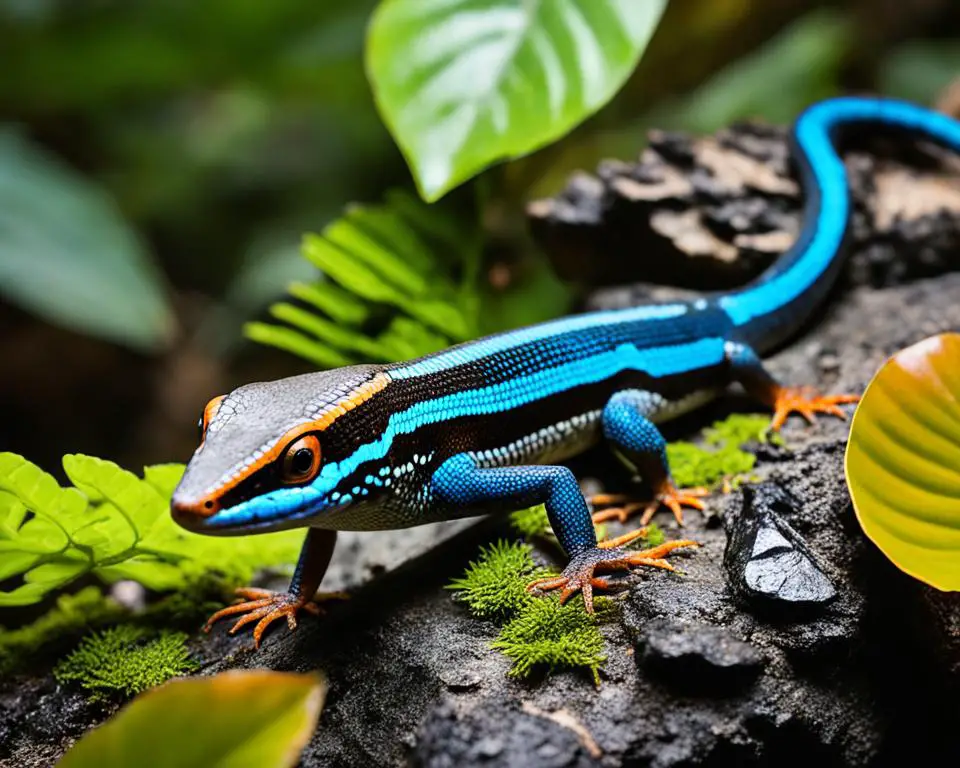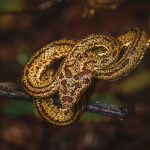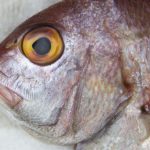If you’re fascinated by the world of reptiles and always ready to explore unique species, then skinks are sure to capture your interest. Known for their distinctive qualities and over 1,500 different types, skinks are some of the most unique reptiles crawling on our planet today. With their small, often barely-there limbs and sleek, snake-like movements, these creatures are a prodigy of adaptation and evolution.
Discover interesting lizard facts that exemplify the diversity and resilience found within the skink species. Whether they are scurrying across the forest floor or expertly burrowing underground, these peculiar lizards demonstrate remarkable survival instincts and behaviors that make them a standout group in the animal kingdom.
Join us as we uncover the remarkable traits and habits that have allowed skinks to thrive across various environments. Ready for a sneak peek into their secretive lives? Let’s dive into the intriguing existence of these amazing creatures.
The Unique Characteristics of Skinks
Among the array of reptilian species, skinks are particularly notable for their extraordinary limb adaptation. Unlike their reptilian counterparts with pronounced limbs, many skinks possess small, sometimes almost nonexistent legs, facilitating their adaptable reptile nature. This adaptation is not merely an anatomical curiosity, but a necessary trait for their survival in diverse environments, enabling them to glide through grass or burrow into the earth with equal skill.
The innovation in limb design is matched by another incredible characteristic: regeneration in skinks. If caught by a predator, a skink can sacrifice its tail, which will continue to wriggle and distract its assailant. This act of self-amputation is known as autotomy and it’s a clear demonstration of how adaptable reptiles like skinks have evolved to survive encounters with predators.
Adaptable Limbs: From Legs to Slithers
For skinks, limb adaptation has been a key evolutionary asset, permitting them to thrive in terrains where other lizards couldn’t. Their versatile limbs allow them to navigate through tight spaces and dense underbrush or seamlessly blend into the arid desert sands. This remarkable adaptability gives insight into the resilient nature of these scaly survivors.
Regeneration Capabilities: The Skink’s Tail Tale
Similarly, the power of regeneration in skinks is a form of adaptation that is as practical as it is fascinating. A detached tail does not mean the end for these creatures. In time, they can regrow a portion of their tails, although the new appendage may be shorter and differ in color or texture from the original. Nevertheless, this capability underscores the tenacity and enduring spirit of the skink.
- Adaptive limb structure for diverse environments
- Ability to regenerate lost tail segments
- Evolved defense mechanisms like autotomy
These unique characteristics not only make skinks a wonder to behold for reptile enthusiasts but also serve as a testament to the enduring and adaptable nature of life on earth, with skinks as a prime example of resilience and survival through adaptation.
An Overview of Skink Habitats
As you venture into the varied environments skinks call home, you’ll be amazed at their adaptability, inhabiting a diverse spectrum of reptile habitats and natural settings. Making their homes in regions as lush as the Great Lakes-St. Lawrence vicinity and as sunny as the Lake Erie shoreline, skinks epitomize the capacity for reptilian survival in contrasting ecozones. Let’s delve into an exploration of these natural skink homes and uncover where these fascinating creatures thrive.
Particularly remarkable is the skink’s versatility; whether nestling under rocks, concealing themselves beneath fallen trees, or camouflaging amidst leaf debris, these reptiles are masters of their domain. Equally adept are species who seclude themselves underground, creating burrows to elude predators and sustain their elusive nature.
In their native habitats like Australia and New Guinea, skinks are no less resourceful. From the sunbaked expanses of the Outback to the verdant serenity of forested regions, skinks demonstrate a ubiquitous presence throughout numerous skink environments. It’s in these variegated landscapes that skinks truly showcase their skill at creating reptile habitats that are both secure and comfortable.
Here’s a closer look into the types of environments these skilled reptiles inhabit:
- Woodland Floors: Taking cover under organic debris and dense foliage.
- Coastal Dunes: Utilizing the sandy terrain for burrowing and foraging.
- Rainforests: Climbing and living within the lush arboreal highways.
- Grasslands: Blending into tall grasses, skinks thrive in open, sunny environments.
- Deserts: Mastering the extreme heat and cold with daytime activity and nighttime refuge.
In harnessing these skink environments, the reptiles not only ensure their survival but also contribute to the ecological balance, playing their part as both predator and prey. By understanding and respecting the reptile habitats that skinks depend on, you can appreciate the integral role these creatures play in the larger tapestry of biodiversity.
The Diverse Diet of Skinks
As a curious observer of the reptilian world, you’ll find the skink diet to be a fascinating display of adaptability and survival. These creatures aren’t your average backyard lizards; they are a group of insectivorous reptiles and omnivorous lizards, exhibiting varied feeding habits that ensure their success across multiple habitats. In this section, we’ll explore the skink’s flexible dining preferences which contribute greatly to their ecological role.
Insectivorous Appetites: Insects as a Mainstay
Many skinks, those insectivorous reptiles you might catch darting after prey, have a diet consisting primarily of insects. Their swift and agile movements allow them to hunt a variety of critters, including crickets, flies, and grubs. Below the earth’s surface, they forage for earthworms, millipedes, slugs, and snails, using their keen senses to locate their next meal. This diet not only provides them the energy they need to thrive but also helps regulate insect populations in their environments.
Omnivorous Options: A Plant and Animal Fusion
Not all skinks are solely meat-eaters; some exhibit an omnivorous taste. For instance, the renowned blue-tongued skink expands its menu to include a wide range of plants. Berries, fruits, and even flowers are on the dining table alongside their favored protein-packed insects and gastropods. This fusion of flora and fauna in their diet reveals another layer of their adaptability, allowing them to thrive in a variety of ecosystems.
To better understand the diversity of a skink’s diet, let’s take a look at what these scale-covered gourmands might consume:
| Insectivorous Diet | Omnivorous Diet |
|---|---|
| Crickets | Berries |
| Flies | Fruits |
| Worms | Flowers |
| Millipedes | Vegetables |
| Spiders | Seeds |
Whether they’re on the hunt for a six-legged snack or browsing the buffet of the forest floor, skinks are skilled at adapting their diet to the resources available. This versatility not only makes them a pivotal part of the food chain but also showcases nature’s intricate web and how each creature fits into it. As you explore the world of these fascinating reptiles, keep an eye out for the various ways skinks sustain themselves—truly an adaptable and enduring species.
Skinks’ Role in the Fossil Record
When we delve into the prehistoric timeline and explore the fossil record, skinks provide us with a fascinating glimpse into the history of reptile evolution. Evidence suggests that these prehistoric lizards were scuttling across ancient landscapes long before humans entered the scene. Setting the stage for present-day skink evolution, the jaws of these creatures aged around 140 million years mark a captivating chapter in natural history.
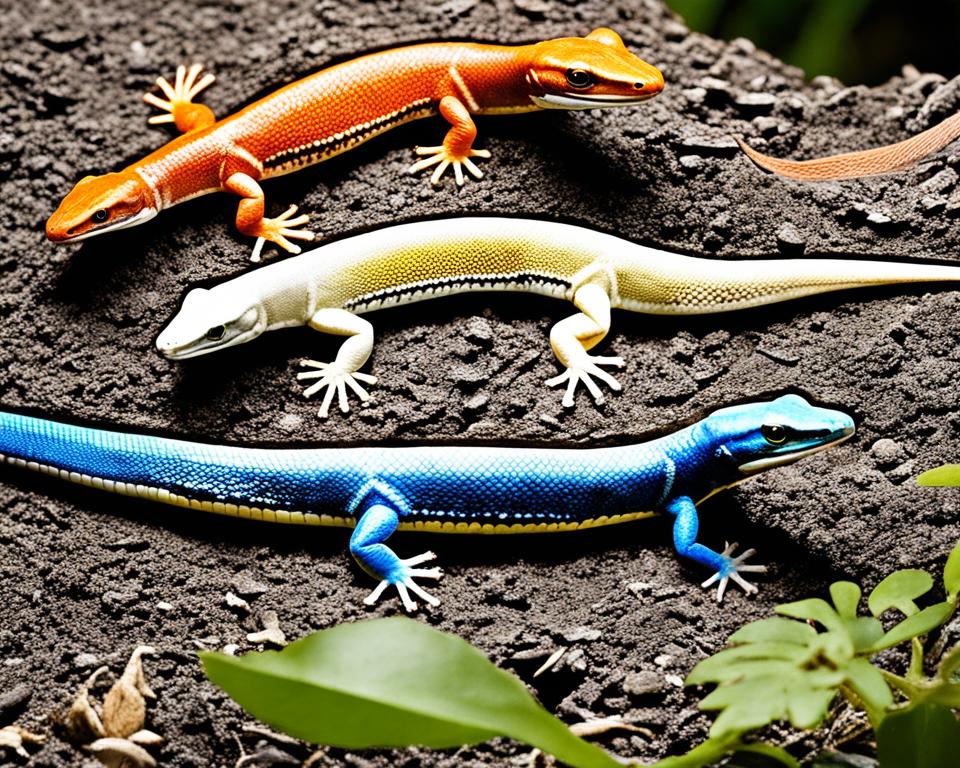
As time marched on, the perseverance of skinks was etched into the Earth’s rocky archives. Their presence in the Miocene period’s sedimentary layers offers a crucial puzzle piece in understanding the lineage of today’s diverse skink populations. Perhaps you’re excited by the notion that the soil we tread upon might just hold secrets from an age when these adaptable lizards roamed in abundance.
Evolutionary Insight: From Ancient Jawbones to Modern-Day Skinks
Traversing the bridge from the distant past to our current era, the skinks’ evolutionary journey is nothing short of remarkable. From the early evidence of skink jawbones in the fossil record, a panoramic view of skink evolution unfolds, revealing how these skinks have adapted over millennia. As you absorb this information, consider the incredible array of habitats that skinks have conquered, becoming a prevalent force in ecosystems worldwide.
Their enduring legacy serves as a testimony to the adaptability and resilience of skinks amid a changing planet. Each fragment of bone and each definitive fossil uncovered allows you to peek into an epoch where prehistoric lizards such as skinks began their enduring legacy, contributing immensely to the biodiversity we cherish today.
Understanding Skink Behavior
Delving into the world of these intriguing reptiles, you’ll find that skink behavior is a significant aspect of their survival. Although they’re often overlooked, skinks are fascinating solitary reptiles that showcase a suite of unique behaviors evolved over millions of years. Their day-to-day actions provide a window into the lives of these diurnal lizards, highlighting their adaptation to thriving in various environments.
Social Solitude: The Skink’s Solitary Nature
Observations of skink behavior reveal that they generally prefer to go about their lives on their own. Unlike many mammals that may form complex social structures, skinks are definitive solitary reptiles, with interactions primarily driven by the need to reproduce. Outside of the mating season, these scaly foragers navigate their world alone, showcasing an independent lifestyle that is truly admirable.
Daylight Activities: A Diurnal Lifestyle
As diurnal lizards, skinks make the most of the daylight, engaging in various activities that cater to their needs. In the warmth of the sun, they actively search for food, relying on their sharp eyesight and keen sense of smell to locate prey. The bright daylight hours are perfect for these reptiles not only to forage but also to bask on a rock or log, absorbing the heat necessary for regulating their body temperature.
Your understanding of these adaptable creatures is enhanced by this knowledge, and the next time you see one in nature or even in a terrarium, you’ll have a deeper appreciation for the solitary and sun-seeking behaviors that define skinks. With every sighting, remember you’re observing a creature superbly adapted to its way of life—one that has been fine-tuned over the eons.
The Five-Lined Skink: A Closer Look
When you discover the five-lined skink in its natural Ontario habitat, you’re immediately struck by its vivid and distinctive appearance—a characteristic that makes this species one of the most striking reptiles in the region. The secrets these creatures carry, especially during their hibernation, are as captivating as their bright markings.
Distinctive Appearance: Stripes and Metallic Blue Tails
The five-lined skink is easily recognized by its dazzlingly bright, metallic blue tail and a body adorned with five light-colored stripes running from the snout to the tail’s base. This incredible coloration is not just a visual treat but serves as a key identifier among the different reptile species found in Ontario. As these reptiles mature, their colors transition into a more subdued brown-grey palette, yet they retain the quintessential stripes that are indicative of their youth.
Adventures in Hibernation: Uncovering the Mystery
Of all the hibernation secrets in the animal kingdom, those of the five-lined skink remain particularly enigmatic. From September to May, they retreat from the observable world, and researchers are intent on uncovering the intricacies of this period. What is known is that during this time, these skinks are hidden from view, preserving their energy and marking the colder months in quiet solitude. Learning more about how these skinks survive the hibernation season could unlock new knowledge about the resilience and adaptability of these fascinating creatures.
As you engage with the world of the five-lined skink, keep in mind the importance of their preservation. Their hibernation secrets and striking colors are but a glimpse into the complex tapestry of biodiversity that we’re just beginning to understand. Marvel at their striking appearance when you’re lucky enough to spot one, and respect the mystery of their unseen months, for these actions support the curiosity and conservation these amazing creatures so richly deserve.
Endangered Existence: Protecting Skink Populations
As devoted stewards of wildlife, we’re confronted with the challenge of safeguarding skink populations that are teetering on the brink of endangerment. With the charming Five-lined Skink under increasing threat in locales like Ontario, the call to step up conservation efforts is louder than ever. Habitat protection and awareness are crucial in reversing the decline of these endangered lizards and ensuring their future.
Habitat Preservation: The Road to Skink Conservation
True conservation begins with the protection of the natural surroundings these creatures call home. To effectively support skink conservation, it’s vital to maintain the integrity of their environments. This includes curbing developments that lead to habitat fragmentation and ensuring natural spaces remain undisturbed and plentiful. Through concerted habitat protection, we lay the groundwork for recovering these unique and endangered lizards.
The Impact of Human Activity: Threats from Poaching to Habitat Loss
The fragile existence of skinks is further jeopardized by direct human activities such as poaching and irresponsible pet trade. However, we each have the power to make a difference. By reducing vehicular speeds in known skink habitats and resisting the temptation to remove these creatures from their natural settings, we can mitigate the impact of human activity. Your engagement in community science can augment our collective knowledge and galvanize conservation efforts, ensuring a future where skinks continue to thrive.
- Advocate for and engage in habitat protection initiatives
- Exercise caution and care when driving through skink-inhabited areas
- Contribute to community science projects to aid in skink conservation
Fun Facts About Skinks
Welcome to the curious world of skinks, where quirky lizard facts abound and reptile enthusiasts delight in learning more about these fascinating creatures. With over 1,500 species, skinks are a treasure trove of unique behaviors and characteristics that never cease to amaze. Let’s dive into some skink trivia that will surprise and enchant you.
Did you know that skinks can be quite the solo travelers? Unlike many animals that travel in packs, these reptiles tend to be solitary, only coming together during the brief mating season. This independent streak is just one of the many intriguing facets of skink behavior.
Skinks are also quite the escape artists. If they ever find themselves in a tight spot with a predator, they have the ability to break off their tail that continues to move, creating a distraction that allows them to escape. Don’t worry though, they can regenerate their tails over time!
- Escape Mechanics: Skinks’ tails can detach to distract predators, a wild survival tactic sure to fascinate.
- Colorful Youth: Young skinks often sport vibrant blue tails, which fade as they age, but always retain a certain charisma.
- Nocturnal Mysteries: The secretive hibernation habits of skinks from September to May spark wonder in the minds of their admirers.
It’s not just their survival skills that are impressive; skinks also play a crucial role in the ecosystem. They help control insect populations, making them natural pest controllers wherever they roam.
And for those with a penchant for prehistory, skinks have a long evolutionary tale to tell. Their lineage dates back millions of years, with evidence found in the fossil record from as far back as the early Cretaceous period. Imagine, these incredible reptiles have been scuttling across the earth since the time of the dinosaurs!
Get ready to embark on an exploratory journey into the lives of these extraordinary lizards. From their distinctive tails to their solitary nature, let’s celebrate the multifaceted world of skinks. So, to all you reptile enthusiasts out there, keep your eyes peeled for these amazing creatures, which are surely one of nature’s most exceptional and adaptable survivors.
Skink Reproduction: An Egg-laying Enigma
Embarking on the mysteries of skink reproduction, you’ll find that the reproductive habits of these egg-laying lizards encapsulate a blend of intrigue and self-sufficiency. Witnessing how nature has streamlined the process to foster independence from the outset is truly remarkable. The maternal chapter of a skink’s life, although brief, is critical for perpetuating the species and highlights the resilient cycle of reptile reproduction.
For these lithe and adaptable creatures, the art of survival begins long before their first breath of air. Let’s scrutinize the unique approach skinks take towards continuing their lineage.
Maternal Instincts: Limited to Laying Eggs
Throughout the animal kingdom, maternal instincts manifest in various capacities, yet for skinks, it’s a rather no-frills affair. The female skink dedicates her energy to creating a secure nest under logs or within the cradle of rocks, laying up to a dozen eggs — a remarkable achievement for these egg-laying lizards. And then, in a twist of nature, her role reaches an abrupt end.
Approximately a month after the eggs are tenderly placed by the female, they hatch and the young skinks emerge, entering the world as miniature versions of their adult counterparts. And from this moment on, they’re left to navigate the complexities of life solo, illustrating the independence ingrained in reptile reproduction.
It’s a survival tactic that imparts a crucial lesson in resilience. As these young skinks venture into the world, instinct is their guide. They forge paths, forage for sustenance, and learn to elude predators, encapsulating the very essence of survival from their earliest days.
Understanding the nuances of skink reproduction enlightens us on the marvels of the natural world, where the cycle of life is orchestrated by instinct and adaptability. As you continue to explore the wonders of reptiles, let the story of the skink’s emergence inspire you to appreciate the meticulous designs of nature, where even the simplest actions serve a grander purpose in the tapestry of life.
Escaping Predators: The Skink’s Survival Strategies
Within the dynamic arena of the wild, skinks have honed a remarkable range of tactics to evade their natural foes. These survival strategies are not just fascinating but pivotal for the continuation of their species. In a theater where predator and prey play a perennial game of hide and seek, skinks have developed an assortment of defense mechanisms that are as unique as they are effective.
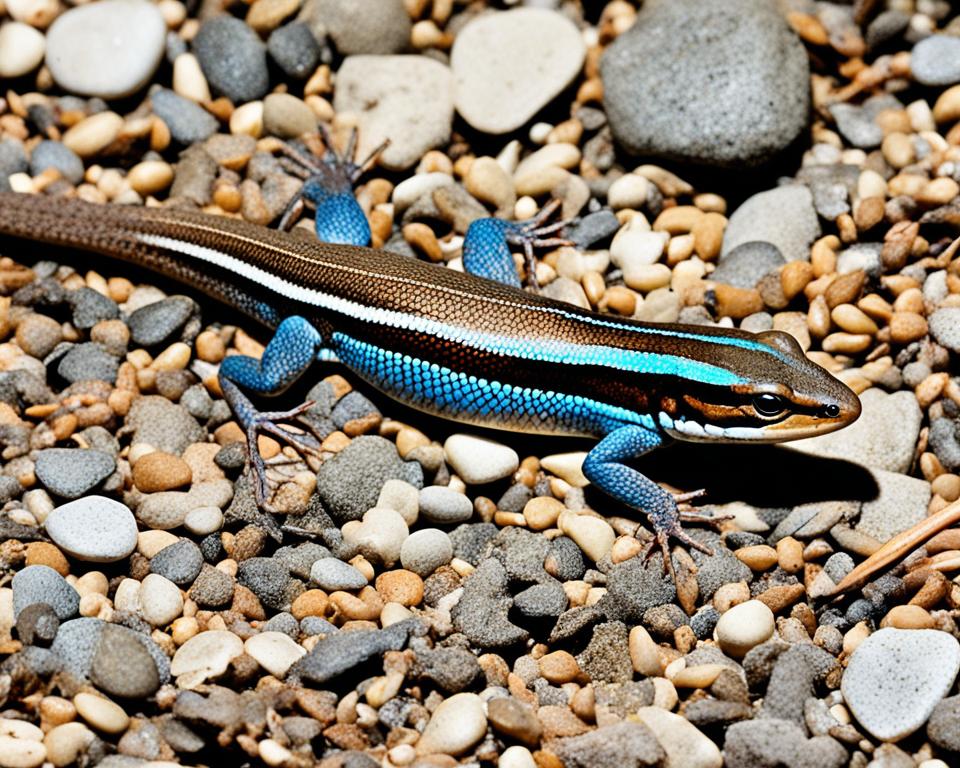
Distractive Display: The Tail Break Trick
One of the most ingenious skink defense mechanisms is the ability to detach their tail when threatened. This action is not only surprising but also serves a critical function in predator evasion. When grasped by an aggressor, the skink’s tail snaps off and enters a frenzied thrashing, providing a vital moment for the skink to execute its survival strategies and escape to safety.
The tail’s energetic wriggling after detachment captures the predator’s attention, creating a deceptive allure away from the fleeing skink. Remarkably, this act of self-sacrifice is not final; with time, the skink can regenerate the lost tail. Although typically shorter than the original, the regrown appendage stands as a testament to the skink’s resilience and determination to survive in the wild.
- Autotomy – losing the tail to survive a predatory attack
- Regeneration – the remarkable ability to grow back the severed tail, albeit shorter
- Evasive action – agile and quick maneuvers to avoid predators
The knowledge of these survival strategies imparts a greater appreciation for these adaptable reptiles and their place in the ecosystem. As you observe skinks in their natural habitat or read about their remarkable capabilities, you’re privy to the marvels of evolution that enable such sophisticated methods of predator evasion.
Blue-Tongued Skinks: Icons of the Species
When you’re exploring the diverse realms of reptiles, blue-tongued skinks emerge as true icons within the skink family. With their vivid, cobalt-hued tongues and intriguing survival tactics, these reptiles not only captivate onlookers but also illustrate the complexity of reptile defense strategies and skink diets. Let’s delve into the unique lifestyle of the blue-tongued skink, a fascinating example of reptilian diversity and adaptability.
The Blue Tongue Defense: A Startling Sight
Among the remarkable traits of blue-tongued skinks is their signature defense strategy. When confronted by potential threats, these skinks exhibit a startling display: they puff up their bodies while sticking out their long, blue tongues and emit a fierce hiss. This startling visual and auditory display is often enough to deter many would-be predators. When puffing up fails to impress, they proceed to flatten their bodies, attempting to appear too large and formidable for an attack.
Omnivorous Blue-Tongued Skink: Diet Details
Blue-tongued skinks are known for their eclectic, omnivorous diet, which plays a pivotal role in their survival. As generalists when it comes to food, they enjoy a varied menu featuring both animal and plant matter. From protein-rich insects to the natural succulence of fruits and the delicate petals of flowers, their dietary choices reflect the diverse offerings of their habitats.
| Animal-Based Prey | Plant-Based Foods |
|---|---|
| Insects | Fruits |
| Worms | Flowers |
| Snails | Vegetables |
| Berries | Seeds |
This remarkable ability to adapt their diet based on availability is essential for the blue-tongued skink’s success in diverse environments, making them resilient and integral components of their ecosystems. Acknowledging the adaptability of blue-tongued skinks is crucial, as it highlights their role in maintaining a balanced food web and reinforces their status as fascinating members of the reptile community.
Conservation Efforts and Community Science
As a guardian of our natural world, your involvement in wildlife conservation is vital, especially when it comes to protecting endangered reptiles such as skinks. With numerous species teetering on the edge of survival, taking measures to safeguard these creatures extends beyond the mere preservation of their habitats—it’s about actively participating in their continued existence. Citizen science initiatives empower you to play a direct role in this odyssey of conservation.
It’s a disheartening reality that skinks, with their fascinating ability to regenerate their tails and adapt to a variety of environments, are imperiled because of activities like habitat destruction and the illegal pet trade. However, you can create a beacon of hope by reporting sightings and engaging in citizen science projects. This data not only aids researchers in understanding skink behavior and distribution but also helps to formulate effective conservation strategies to protect these vulnerable species.
Your participation in community science is a simple yet impactful way to contribute:
- Record and report sightings of skinks in your local area, aiding in the mapping of their habitats.
- Support local wildlife conservation initiatives by volunteering your time or resources.
- Help increase awareness by educating others about the importance of conserving ecosystems for skinks and other endangered reptiles.
Below is a table illustrating the direct impact community science has on wildlife conservation efforts concerning skinks:
| Community Science Actions | Conservation Impact |
|---|---|
| Reporting of Skink Sightings | Enhances knowledge of population distribution and trends. |
| Participation in Habitat Cleanups | Directly improves skink habitats, promoting healthier ecosystems. |
| Educational Outreach | Raises public awareness and reduces negative human-skink interactions. |
| Advocating Against Pet Trade | Decreases the demand for wild-caught skinks, reducing poaching. |
In this plight to protect and rejuvenate skink populations, remember that every action, no matter the scale, has the potential to make a lasting difference. Together, with your hands in the soil and your eyes on lookout, you become a crucial part of a global network of conservationists, scientists, and informed citizens united in the cause for a planet teeming with the wonderful and wild diversity of life.
Conclusion
As our exploration of skinks draws to a close, your newfound understanding of these fascinating skinks anchors a deeper appreciation for the intricate tapestry of our ecosystems. The unique characteristics, varied habitats, and the adaptive diets of skinks paint a vivid picture of reptilian resilience and versatility. However, beyond their captivating natural history and the awe they inspire, skinks play a pivotal role in maintaining the delicate balance of our ecosystems. It’s this very role that underscores the pressing need for skink awareness and reptile preservation.
Your awareness and actions can make a significant difference as we strive to protect these remarkable creatures. By promoting skink awareness, you become a voice for their plight, encouraging others to learn about and appreciate the diversity and importance of skinks. Moreover, active participation in reptile preservation efforts helps ensure that the enchanting world of skinks does not fade into obscurity but continues to thrive. It’s a commitment to fostering environments where future generations can also marvel at the tiny but mighty skink.
In the collective quest for wildlife conservation, remember that every encounter with a skink is an opportunity to celebrate and participate in their ongoing survival story. So, as you step forward into the world, carry the mission of skink preservation in your heart, and let your actions reflect the same adaptability and tenacity that these fascinating skinks demonstrate in their daily lives. Together, let’s ensure these incredible reptiles continue to be a testament to nature’s beauty and diversity for years to come.

